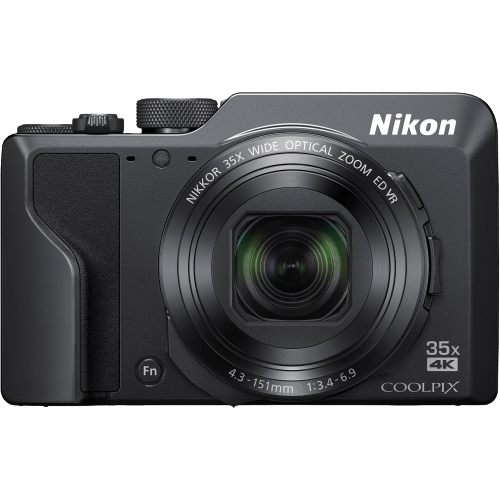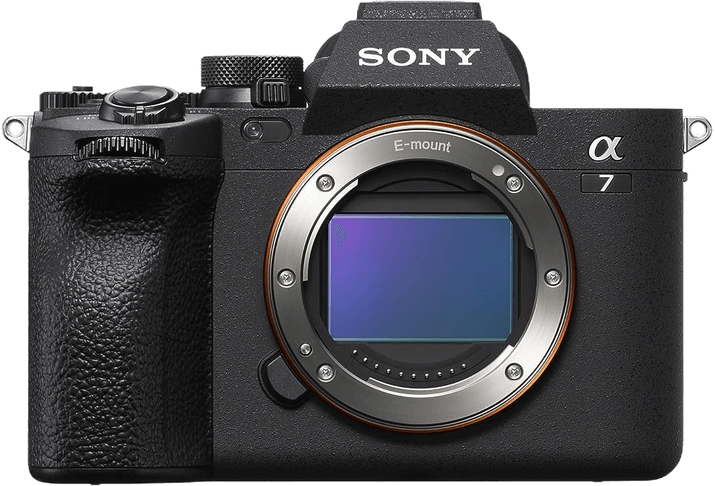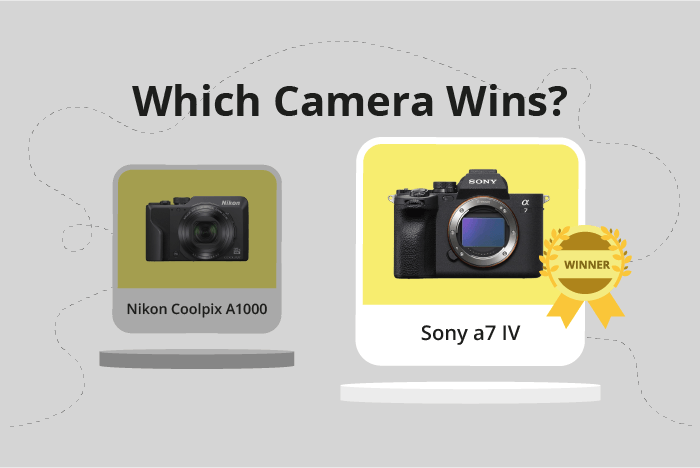Nikon Coolpix A1000 vs Sony a7 IV Comparison
Nikon Coolpix A1000

Sony a7 IV

The Sony a7 IV emerges as the winner with a score of 84/100, outperforming the Nikon Coolpix A1000 by a significant 31 points. Both cameras share common specifications, such as their release years (2019 for Nikon and 2021 for Sony) and respective announcement dates.
The Sony a7 IV excels with its mirrorless camera design, offering superior performance and image quality. Its larger size (131 x 96 x 80mm) and heavier weight (659g) may indicate a more robust build and advanced features compared to the Nikon Coolpix A1000.
On the other hand, the Nikon Coolpix A1000 is a compact camera with a smaller size (114 x 72 x 41mm) and lighter weight (330g) making it more portable. However, its lower score of 53/100 suggests that it may not match the Sony a7 IV in terms of overall performance and capabilities.
Taking all factors into account, the Sony a7 IV outshines the Nikon Coolpix A1000, making it the better choice for those seeking a high-quality camera with advanced features. However, the Nikon Coolpix A1000 remains a viable option for users prioritizing portability and affordability.
Nikon Coolpix A1000 vs Sony a7 IV Overview and Optics
The Sony a7 IV outperforms the Nikon Coolpix A1000 in optics, scoring 85/100 compared to the A1000’s 55/100. Both cameras share some common specifications, such as 10 fps shooting speed, CMOS sensor type, and image stabilization. However, the Sony a7 IV surpasses the Nikon A1000 in several key aspects.
The Sony a7 IV boasts a higher megapixel count at 33, compared to the Nikon A1000’s 16 megapixels. This difference allows the a7 IV to capture more detail and produce higher resolution images. The a7 IV also benefits from a more advanced processor, the Bionz XR, which contributes to better image quality and faster processing times.
Another significant advantage of the Sony a7 IV is its full-frame sensor size, as opposed to the Nikon A1000’s smaller 1/2.3″ sensor. A larger sensor typically results in improved low-light performance, dynamic range, and overall image quality. The a7 IV’s DXOMARK sensor score of 97 further supports its superior performance over the A1000, which has a score of 72.
The Sony a7 IV also features a Sony FE lens mount, allowing users to interchange lenses and customize their shooting experience. The Nikon A1000, however, uses a fixed lens mount, limiting its versatility.
Despite these advantages, the Nikon A1000 does have a slight edge in aspect ratio, offering a 4:3 ratio compared to the Sony a7 IV’s 3:2 ratio. This difference may be preferable for some users depending on their specific needs and preferences.
Comparing the optics of both cameras, the Sony a7 IV emerges as the clear winner with its higher megapixel count, advanced processor, larger sensor size, and interchangeable lens mount. The Nikon Coolpix A1000 may still appeal to those who prioritize a 4:3 aspect ratio, but overall, the Sony a7 IV offers superior performance in optics.
Nikon Coolpix A1000 vs Sony a7 IV Video Performance
The Sony a7 IV outperforms the Nikon Coolpix A1000 in video capabilities, with a 21-point higher score (91/100 compared to 70/100). Both cameras share common specifications, including 4K max video resolution, 3840 x 2160 max video dimensions, and built-in time-lapse functionality. However, the Sony a7 IV has distinct advantages over the Nikon Coolpix A1000.
The most significant advantage of the Sony a7 IV is its higher max video frame rate of 120fps, compared to the Nikon Coolpix A1000’s 30fps. This higher frame rate allows for smoother video playback and better slow-motion effects, enhancing the overall video quality. The Sony a7 IV’s superior video performance makes it an ideal choice for videographers and content creators who require top-notch video capabilities.
The Nikon Coolpix A1000, while having a lower video score, still offers decent video quality with its 4K resolution and built-in time-lapse functionality. This camera may be suitable for casual users or those who prioritize other features over video performance.
To conclude, the Sony a7 IV is the clear winner in terms of video capabilities due to its higher video score and superior max video frame rate. The Nikon Coolpix A1000, though not as strong in this area, can still deliver satisfactory video quality for casual users. When considering which camera to purchase, potential buyers should weigh the importance of video performance against other factors and features relevant to their needs.
Nikon Coolpix A1000 vs Sony a7 IV Features and Benefits
The Sony a7 IV outperforms the Nikon Coolpix A1000 with a feature score of 83/100, a 21-point difference compared to the Nikon’s 54/100. Both cameras share several specifications, including a 3-inch screen size, touchscreen functionality, flip screen, WiFi connectivity, and lack of GPS.
The Sony a7 IV has a higher screen resolution at 1,040,000 dots compared to the Nikon’s 921,000 dots, providing clearer and sharper image previews. Additionally, the Sony a7 IV offers Bluetooth connectivity, which the Nikon Coolpix A1000 lacks. This feature allows for seamless wireless communication between the camera and compatible devices, such as smartphones and tablets.
The Nikon Coolpix A1000, on the other hand, does not have any significant advantages over the Sony a7 IV in terms of features. The only noteworthy difference is its lower feature score, which does not impact the camera’s overall performance or quality.
Taking these factors into account, the Sony a7 IV is the clear winner in terms of features, offering a higher screen resolution and Bluetooth connectivity that the Nikon Coolpix A1000 does not provide. The Nikon, however, remains a viable option for users who prioritize other aspects, such as price or size, over advanced features. Ultimately, the choice between these two cameras depends on individual preferences and requirements, but in terms of features alone, the Sony a7 IV emerges as the superior option.
Nikon Coolpix A1000 vs Sony a7 IV Storage and Battery
The Sony a7 IV outperforms the Nikon Coolpix A1000 in storage and battery with a score of 76/100 compared to the Nikon’s 29/100. Both cameras accept SD cards and offer USB charging. However, the Sony a7 IV has two memory card slots, accepting both CFexpress Type A and UHS-II compatible SD cards, while the Nikon A1000 has only one slot for SD, SDHC, and SDXC cards.
The Sony a7 IV also boasts a longer battery life with 580 shots per charge, using the NP-FZ100 battery. In contrast, the Nikon A1000 offers 250 shots per charge, relying on the EN-EL12 battery. This advantage makes the Sony a7 IV more suitable for extended shooting sessions.
On the other hand, the Nikon Coolpix A1000’s simpler storage options may appeal to casual photographers who do not require advanced memory card compatibility or extensive battery life. The single SD card slot and shorter battery life might suffice for everyday photography needs.
In comparing these cameras, the Sony a7 IV clearly excels in storage and battery capabilities, making it the superior choice for professional photographers and those seeking longer shooting sessions. The Nikon Coolpix A1000 may be suitable for casual users who prioritize simplicity and affordability over advanced storage and battery features.
Nikon Coolpix A1000 vs Sony a7 IV – Our Verdict
Are you still undecided about which camera is right for you? Have a look at these popular comparisons that feature the Nikon Coolpix A1000 or the Sony a7 IV:

